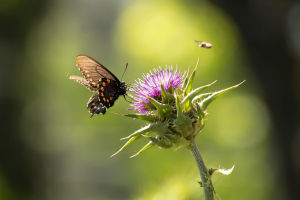Fascinating Ladybug Facts
Hey Lykkers! If you're a fan of cute critters and beneficial garden helpers, you've probably come across ladybugs, also known as ladybird beetles. These bright, red, or yellow insects are loved for their natural pest control abilities, particularly their knack for munching on aphids and other garden pests. But did you know ladybugs are not actually “bugs”?
They belong to the beetle family, specifically the Coccinellidae family, and have been around for more than 500 years! European farmers initially called them "lady birds," and in the U.S., we call them ladybugs, though scientists prefer to use the more formal “lady beetle.”
1. Ladybugs Aren't Always Red and Black
We're used to seeing ladybugs with their signature red bodies and black spots, but they can come in a rainbow of colors! From orange and yellow to black and even white, these beetles sport different shades depending on the species. There are over 5,000 types of ladybugs in the world, and around 450 of them call North America home. The colors are often linked to their habitats, with species in more general environments sporting simpler color patterns, while those in specialized areas might have more complex designs. Some ladybugs even change color with the seasons!
2. "Lady" Refers to the Holy Mary
Here's a fun historical tidbit for you! The name “ladybug” comes from the Middle Ages when farmers prayed to the Holy Mary for help with crop pests. As the story goes, ladybugs appeared in their fields, saving the crops from the harmful insects. The name "ladybird" comes from this connection, with the German word “Marienkäfer” meaning "Mary's beetle." The seven-spotted ladybug is often associated with the Holy Mary, with the red color symbolizing her cloak and the black spots representing her seven sorrows.
3. Ladybugs Defend Themselves in Style
Ladybugs don't rely on just hiding to stay safe. If a predator threatens them, they can excrete a yellow, smelly fluid from their knees, leaving a foul mark. This disgusting substance helps deter predators and sends a strong signal: "Stay away, I'm not worth eating!" Some species even leak this toxic fluid when they're startled. It's a clever trick that not only helps keep ladybugs safe but also warns predators to steer clear of them.
4. Ladybugs Live About One Year
Ladybugs might seem like they live fast, but they actually go through a full life cycle that can span about a year. It all starts with a batch of bright yellow eggs, usually laid near a food source. The eggs hatch in about 4 to 10 days, and the larvae feed voraciously, often devouring hundreds of aphids. After several weeks of gorging, they form a pupa and, 7 to 10 days later, emerge as full-grown ups. Pretty efficient, huh?
5. Ladybug Larvae Look Like Tiny Crocodiles
Here's a weird but fun fact: ladybug larvae look nothing like their grown-up counterparts. They resemble tiny, spiky crocodiles, with elongated bodies and legs sticking out from the sides. These larvae are formidable hunters, munching on hundreds of aphids in their quest to grow. So, while you might be tempted to think of them as strange-looking, they're actually busy doing the important work of pest control!
6. Ladybugs Eat A Lot of Insects
Ladybugs are awesome when it comes to fighting garden pests. Most ladybugs feast on soft-bodied insects like aphids, mealybugs, scale insects, and spider mites. As larvae, they can consume hundreds of aphids, and even as grown-ups, they're still devouring bugs—up to 50 aphids a day! Over their lifetime, a single ladybug might eat over 5,000 aphids. No wonder gardeners love them!
7. Farmers Use Ladybugs for Pest Control
Did you know that ladybugs are actually used to help manage pests on farms? In the late 1800s, an Australian ladybug species was brought to California to control a scale insect pest that was destroying crops. This experiment was a huge success—California's orange crop doubled in size by 1890! Since then, many other ladybug species have been introduced to fight pests, although some experiments didn't have the same success. Still, ladybugs remain a key natural pest control option for farmers.
8. Ladybugs Can Be Pests Too
Although ladybugs are usually our garden heroes, some species can turn into pests themselves. For example, the Asian ladybug, or Harlequin ladybug, was introduced to North America in the 1980s to control aphids. While it did reduce pest populations, it also displaced native ladybug species. And here's the kicker—these ladybugs can sometimes invade homes during the winter, causing an annoying infestation. Imagine hundreds of ladybugs crawling around your house—yikes!
9. Sometimes Ladybugs Wash Up on Shore
Imagine walking along a beach and finding tons of ladybugs scattered along the shore. Sounds strange, right? But it happens! There are instances where huge numbers of ladybugs end up washed up along coastlines. Scientists aren't exactly sure why this happens, but they believe it might be due to storms, strong winds, or ladybugs floating across large bodies of water. In the 1940s, an estimated 4.5 billion ladybugs washed up along a 21-mile stretch of coastline in Libya!
10. Ladybugs Practice Cannibalism
When food is scarce, ladybugs won't hesitate to eat each other. Hungry ladybugs will feast on soft-bodied siblings, and even their eggs and pupae can become meals for other ladybugs. In fact, some experts believe ladybugs intentionally lay infertile eggs to provide food for their young in tough times. Talk about a survival strategy!
We hope you learned some cool new facts about ladybugs today, Lykkers! These little creatures are not only fascinating but incredibly useful to have around in our gardens. Next time you spot one, you'll know just how special they really are. Keep exploring, and remember—nature is full of wonders waiting to be discovered!
-
 The Rythm of SealsSeals Can Groove? Scientists Say These Ocean Cuties Might Have Better Rhythm Than You!
The Rythm of SealsSeals Can Groove? Scientists Say These Ocean Cuties Might Have Better Rhythm Than You! -
 Butterfly Magic ShowEver Wondered Why Butterflies Shine Like Magic? The Truth Behind Their Wings Will Surprise You!
Butterfly Magic ShowEver Wondered Why Butterflies Shine Like Magic? The Truth Behind Their Wings Will Surprise You! -
 Scratch-Free HomeStop the Scratching: Easy Cat Tricks That Save Your Furniture
Scratch-Free HomeStop the Scratching: Easy Cat Tricks That Save Your Furniture
Contact to : xyjph123@gmail.com
Privacy Agreement
Copyright © boyuanhulian 2020 - 2022. All Right Reserved.
Privacy Agreement
Copyright © boyuanhulian 2020 - 2022. All Right Reserved.